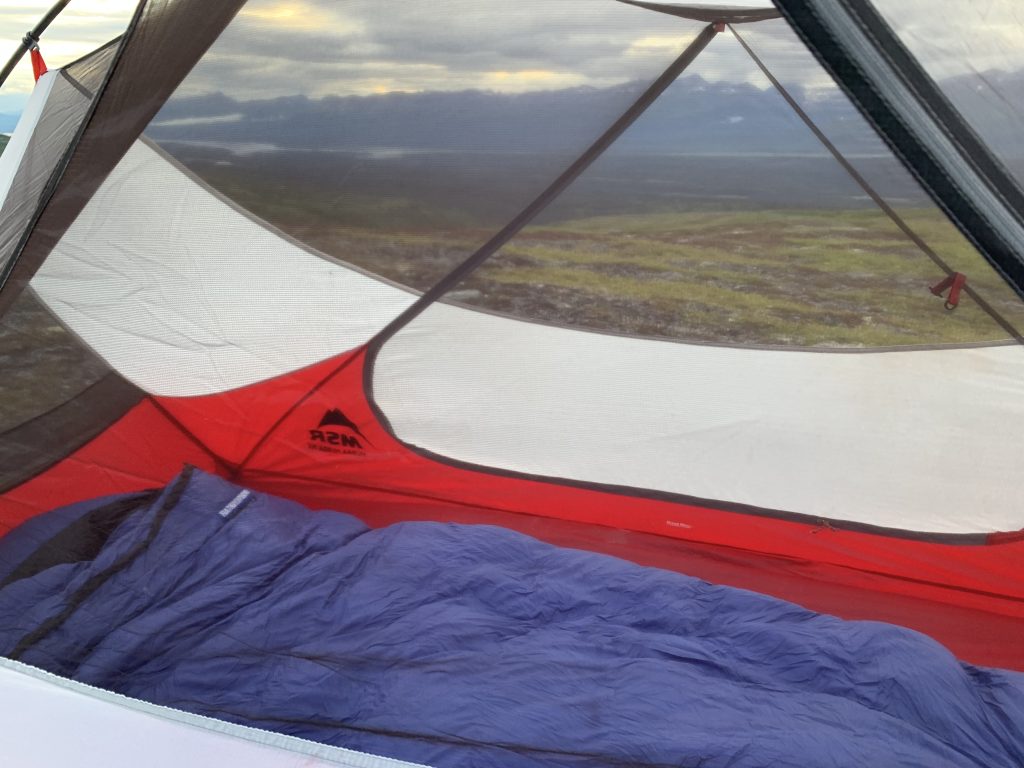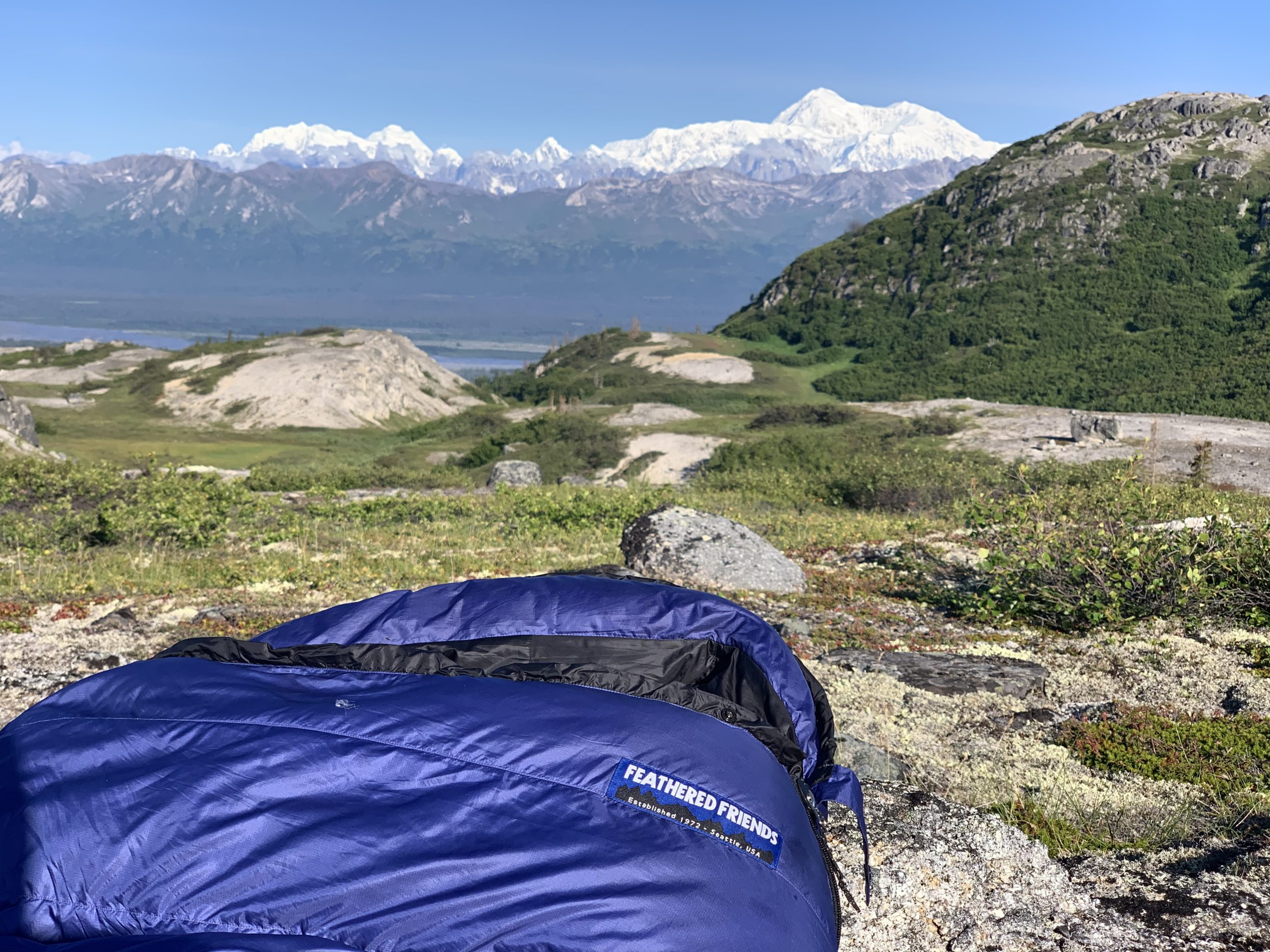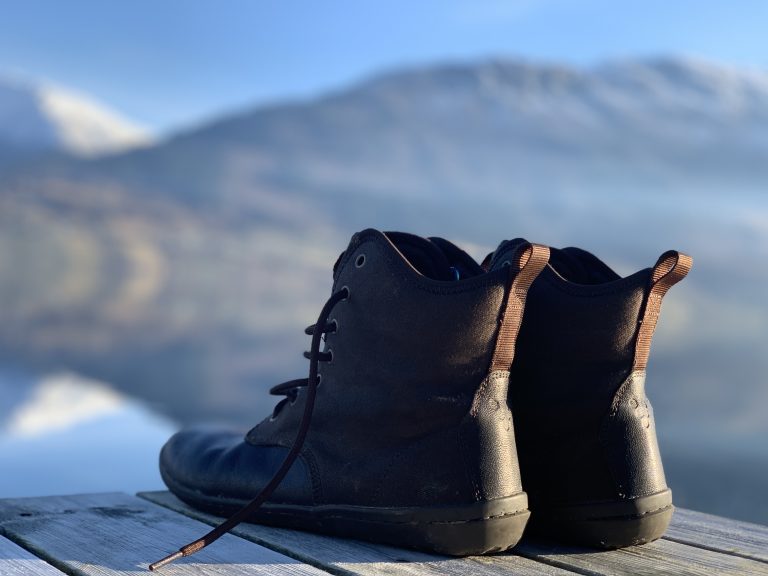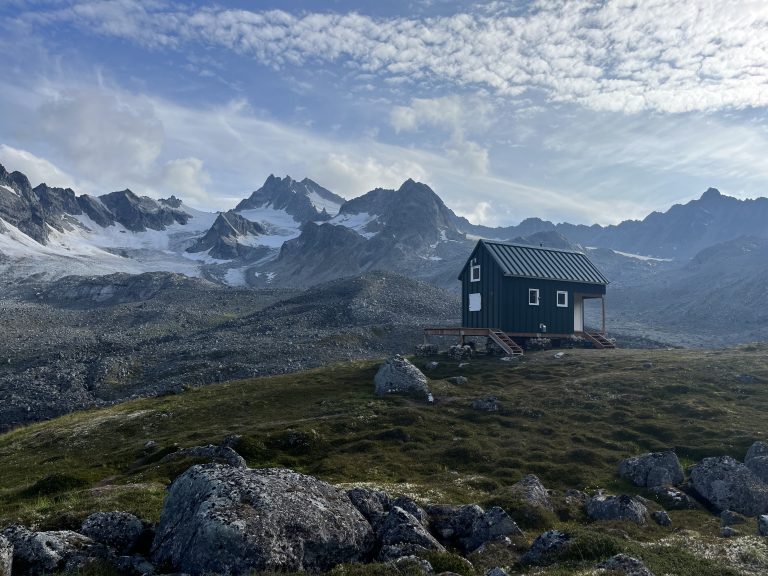Feathered Friends is one of our favorite sleeping bag brands. I have owned one of their bags for 5 years and it continues to be an essential part of my kit. They’re a small brand out of Seattle,WA and they offer high quality down products that meet the ethical down standards (RDS). They also have top-notch customer support.
If you’re looking for a new bag, definitely consider Feathered Friends. Or perhaps you already know you want one of their bags, but aren’t sure which to choose. After buying my own bag, I comprised this blog, highlighting the differences between each bag, recommendations for different types of backpackers, and guidance in understanding all the different variations they offer.
Let’s dig in!
We use affiliate links in this article. This helps support our work at no cost to you. If you buy a bag through one of our links, we will receive a small kickback. Thanks!
The Best Three Season Bags: Hummingbird (20°F) vs. Swallow (20°F) vs. Lark (10°F) vs. Petrel (10°F) vs. Tanager (20°F) vs. Puffin (20°F) vs. Swift (30°F)

Hummingbird (20°F) Overview:
- Type: Ultralight (UL)
- Price: ~$609.00
- Weight: ~1 lb 8 oz
- Fit: Snug mummy design, ideal for those who want to shave some ounces off their backpack.
- Best For: Ultralight hikers seeking warmth and minimal weight for three-season use but aren’t doing “shoulder” camping (camping in late fall), or aren’t very cold sleepers.
Swallow (20°F) Overview:
- Type: Ultralight (UL)
- Price: ~$609.00
- Weight: ~1 lb 14 oz
- Fit: Roomier than the Hummingbird, with more comfort while maintaining warmth.
- Best For: Backpackers who want more space without significantly increasing weight. Again, a 20 degree bag doesn’t work for me, personally, but my brother gets away with it. But I sleep much colder.
Lark (10°F) Overview:
- Type: Ultralight (UL) & Yarn Fabric (YF)
- Price: ~$679.00 (UL) / ~$579.00 (YF)
- Weight: ~2 lbs 2 oz (UL), ~2 lbs 6 oz (YF)
- Fit: Snug mummy design. Warmer and suitable for colder three-season trips or traveling in Alaska in the spring or fall.
- Best For: Backpackers who often encounter colder temperatures, with the YF version offering extra durability and comfort. (I’ve owned the Lark YF for five years and love it!)

Petrel (10°F) Overview:
- Type: Ultralight (UL), Tailored Fit (TF)
- Price: ~$679.00
- Weight: ~2 lbs 5 oz
- Fit: Women-specific with extra insulation in key areas like the torso and footbox.
- Best For: Women or smaller-framed backpackers who run cold and need extra warmth. Warmer and suitable for colder three-season trips or traveling in Alaska in the spring or fall.
Tanager (20°F) Overview:
- Type: Ultralight (UL)
- Price: ~$479.00
- Weight: ~1 lb 2 oz
- Fit: Zipperless and minimalist design, focusing on the lightest possible option.
- Best For: Ultralight backpackers who want maximum weight savings without sacrificing warmth. Great world traveling bag.
Puffin (20°F) Overview:
- Type: Ultralight (UL)
- Price: ~$609.00
- Weight: ~2 lbs 5 oz
- Fit: Semi-rectangular, offering more room and comfort.
- Best For: Comfort-focused backpackers who prioritize space without compromising warmth. This is probably the best choice for anyone who feels a bit claustrophobic in bags.
Swift (30°F) Overview:
- Type: Ultralight (UL)
- Price: ~$609.00
- Weight: ~1 lb 15 oz
- Fit: Traditional mummy design for lighter three-season use.
- Best For: Backpackers looking for a versatile and lighter bag for moderately cold temperatures. I wouldn’t recommend this for anyone doing spring or fall camping in northern environments – or those who sleep cold.
Comparison Table of Three-Season Sleeping Bags
| Sleeping Bag | Type | Price | Weight | Fit | Best For |
|---|
| Hummingbird (20°F) | Ultralight (UL) | $609.00 | 1 lb 8 oz | Snug mummy design, ideal for weight savings | Ultralight hikers for three-season use |
| Swallow (20°F) | Ultralight (UL) | $609.00 | 1 lb 14 oz | Roomier for added comfort | Backpackers wanting space without extra weight |
| Lark (10°F) | Ultralight (UL) & Yarn Fabric (YF) | $679.00 (UL) / $579.00 (YF) | 2 lbs 2 oz (UL) / 2 lbs 6 oz (YF) | Snug mummy design, warmer for colder trips | Backpackers in colder conditions; durable YF option |
| Petrel (10°F) | Ultralight (UL), Tailored Fit (TF) | $679.00 | 2 lbs 5 oz | Women-specific with extra insulation | Women or smaller frames needing extra warmth |
| Tanager (20°F) | Ultralight (UL) | $479.00 | 1 lb 2 oz | Zipperless and minimalist design | Ultralight backpackers focused on weight savings |
| Puffin (20°F) | Ultralight (UL) | $609.00 | 2 lbs 5 oz | Semi-rectangular, spacious | Comfort-focused backpackers preferring space |
| Swift (30°F) | Ultralight (UL) | $609.00 | 1 lb 15 oz | Traditional mummy design | Versatile use in moderate temperatures |
The Best Winter & Expedition Series Bags

Murre EX (-10°F) Overview:
- Price: ~$849.00
- Weight: ~3 lbs 5 oz
- Best For: Best for colder temperatures and long-distance treks. Will keep you very warm and comfortable with a more generous mummy fit.
Snowbunting EX (0°F) Overview:
- Price: ~$879.00
- Weight: ~2 lbs 15 oz
- Best For: This is one of their most popular choices for winter camping. I would take this if I was doing very late season camping in, for example, the North Cascades or Nepal. Lightweight and incredibly warm, this bag is great for winter trips where space and warmth are priorities.
Widgeon EX (-10°F) Overview:
- Price: ~$1,099.00
- Weight: ~3 lbs 2 oz
- Best For: Alpine-style expeditions, perfect for winter adventurers looking for a high warmth-to-weight ratio in demanding conditions. This is the bag I would bring winter camping in most places.
Eider EX (-10°F) Overview:
- Price: ~$1,099.00
- Weight: ~3 lbs 10 oz
- Best For: The roomier version of the Widgeon, ideal for larger-framed adventurers or those who prefer more space for additional layering.
Peregrine EX (-25°F) Overview:
- Price: ~$1,229.00
- Weight: ~4 lbs
- Best For: Perfect for larger-framed backpackers or those looking to pack extra gear (like water bottles, fuel canisters, and maybe food) inside the bag. With superior water resistance and warmth, it’s great for extreme alpine expeditions.
Snow Goose EX (-40°F) Overview:
- Price: ~$1,605.00
- Weight: ~4 lbs 4 oz
- Best For: One of the warmest bags for deep winter and high-altitude expeditions. Excellent for use in extremely cold conditions.
Snowy Owl EX (-60°F) Overview:
- Price: ~$1,866.00
- Weight: ~5 lbs 4 oz
- Best For: The ultimate choice for extreme cold conditions, this is designed for the harshest environments, including Arctic expeditions. Denali anyone?
Comparison Table of Winter Sleeping Bags
| Sleeping Bag | Price | Weight | Best For |
|---|
| Murre EX (-10°F) | $849.00 | 3 lbs 5 oz | Best for colder temperatures and long-distance treks. |
| Snowbunting EX (0°F) | $879.00 | 2 lbs 15 oz | Ideal for winter camping, especially late-season trips in cold areas. |
| Widgeon EX (-10°F) | $1,099.00 | 3 lbs 2 oz | Perfect for alpine-style expeditions; offers high warmth-to-weight ratio. |
| Eider EX (-10°F) | $1,099.00 | 3 lbs 10 oz | Roomier version of the Widgeon, ideal for larger frames. |
| Peregrine EX (-25°F) | $1,229.00 | 4 lbs | Excellent for extreme alpine expeditions, with room for gear storage. |
| Snow Goose EX (-40°F) | $1,605.00 | 4 lbs 4 oz | Designed for extremely cold conditions, suitable for high-altitude expeditions. |
| Snowy Owl EX (-60°F) | $1,866.00 | 5 lbs 4 oz | Ultimate choice for extreme cold, ideal for Arctic expeditions |
What About Quilts?
If you’re someone who wants flexibility and ultralight performance (like my brother), a quilt-style sleeping bag might be a great choice. Feathered Friends’ has a line of quilts called their Flicker series. These offer the versatility of being able to open up in warmer conditions or fully wrap around you on cold nights. They also save weight by eliminating unnecessary fabric and insulation under your body, relying on your sleeping pad for warmth. Quilts are ideal for minimalist backpackers, thru-hikers, or anyone who prefers more freedom of movement at night. Check out our longer investigation into the benefits and drawbacks of quilts.
Do I Need a Woman-Specific Bag?
Women-specific sleeping bags, like the Petrel, are designed with a tailored fit to suit the body shape of women. These bags generally have narrower shoulders, wider hips, and extra insulation in areas where women tend to lose more heat, such as the chest and footbox. If you’re a female backpacker or have a slimmer build, a women-specific bag can enhance warmth and comfort on the trail. However, if you prefer a looser fit or don’t need the extra insulation, a unisex bag will probably work just as well.
Which Size Should I Get?
These bags come in different sizes, and choosing the right one is essential for comfort and warmth. If you’re tall like me (I’m 6’2″), a long sleeping bag is the proper size. I got a long version of the Lark YF, and it fits perfectly. You want enough room to move comfortably but not so much that there’s extra space for cold air to gather. For shorter individuals, standard sizes should work just fine.
What Do UL, TF, ES, EX, and YF Mean?
- UL (Ultralight): Focuses on weight savings while maintaining warmth. These bags are ideal for backpackers aiming to minimize pack weight without sacrificing comfort.
- TF (Tailored Fit): Designed for a closer fit to maximize warmth retention, especially in women’s-specific models like the Petrel, where extra insulation is placed in key areas.
- ES (Expedition Series): Built for extreme cold conditions, offering additional insulation and water-resistant fabrics, designed for winter or high-altitude use.
- EX (Extreme Weather): Provides extra protection for harsh weather conditions, including water-resistant fabric and durability, making it suitable for cold, wet, or snowy environments.
- YF (Yarn Fabric): A more durable, comfortable fabric option, designed to enhance comfort while maintaining the bag’s durability and performance.
How Warm is the Rating, Really?
One important thing to keep in mind when choosing a sleeping bag is that the temperature rating often reflects the minimum temperature at which the bag will keep you alive, but it may not necessarily keep you comfortable or warm at that temperature.
In my experience, the rating is more of a survival indicator. For example, if a bag is rated at 10°F, it means you’ll likely survive the night in 10°F weather, but you might feel cold rather than comfortably warm. The key factor is the difference between the lower limit (survival temperature) and the comfort rating (where you’ll actually sleep comfortably).
The comfort rating is generally about 10 to 15°F warmer than the lower limit rating. So, a bag rated at 10°F might keep you warm down to 20-25°F, but anything lower than that, and you could start feeling the chill, especially without extra insulation like a sleeping pad or base layers.
This is why it’s essential to consider additional insulation and layering when venturing into colder conditions. Adding a sleeping pad with a higher R-value or wearing insulated clothing inside the bag can make a huge difference, especially in weather close to the bag’s lower rating.
For most of my trips, especially in Alaska, I aim for a sleeping bag rated about 10°F colder than the lowest expected temperature. This provides an extra buffer, ensuring that I stay not just alive but also comfortably warm throughout the night.
Buying Advice for Specific Backpackers:
- The Comfort Backpacker: Puffin (20°F) ($609) – Roomy and comfortable for those who prioritize space.
- The Cold Sleeper: Lark (10°F) ($679) or Petrel (10°F) ($679) – Excellent insulation for those who run cold.
- The Bag for Alaska: Lark YF (10°F) ($579) – Great for colder, variable conditions.
- The Ultralight Backpacker: Tanager (20°F) ($479) – The lightest option, perfect for minimalists.
- The Global Adventurer: Flicker (20°F to 30°F) – Versatile quilt design for varied climates.
- The Person Who Might Do Winter Camping: Lark (10°F) – Handles cold, but light enough for regular use.
- The Winter Camper: Snowbunting EX (0°F) ($879) or Ptarmigan EX (-25°F) ($879) – Ideal for extreme winter conditions.
My Personal Preference: Why I Chose the Lark YF
After extensive research, I chose the Lark YF (10°F) for several reasons. First, Alaska’s variable weather requires a bag that can handle colder temperatures, and with a 10°F rating, the Lark YF offers just the right amount of warmth for most of my trips, including fall and spring camping when temperatures can dip low.
I opted for the YF (Yarn Fabric) version for its durability and comfort. While the UL version is lighter, I prioritize comfort and durability, especially for longer trips where the fabric might face more wear and tear. The YF fabric is more rugged and, if I’m dropping $500+ on a bag, I want it to last me a lifetime. I also sometimes cowboy camp, so I didn’t want a bag that I’d be worried about tearing. So far so good. I’ve only had to patch it once, and that was from an ember.
Being 6’2″, I also needed a long version, and the Lark’s sizing was perfect for me. It gives me enough room to move around without feeling constricted but isn’t overly spacious to let cold air gather. I can get it over my head too on a cold night and really snuggle.
After owning and using the Lark YF for five years, I can confidently say it’s been a reliable companion on countless trips, offering the perfect blend of warmth, durability, and comfort.



